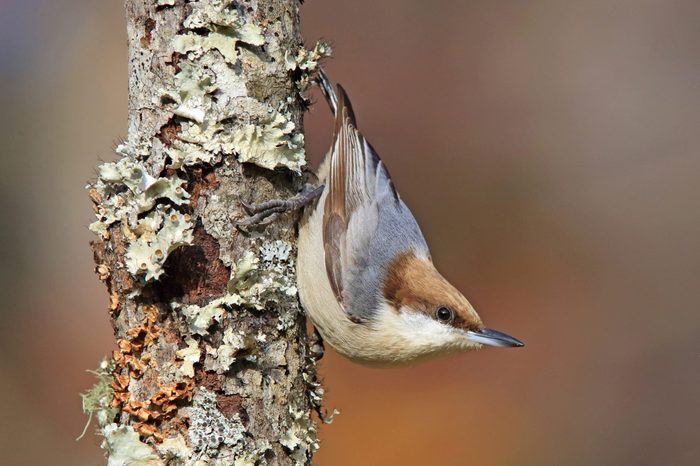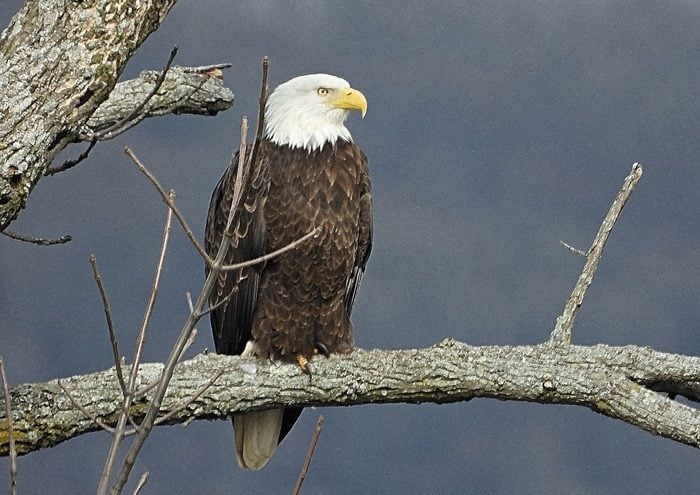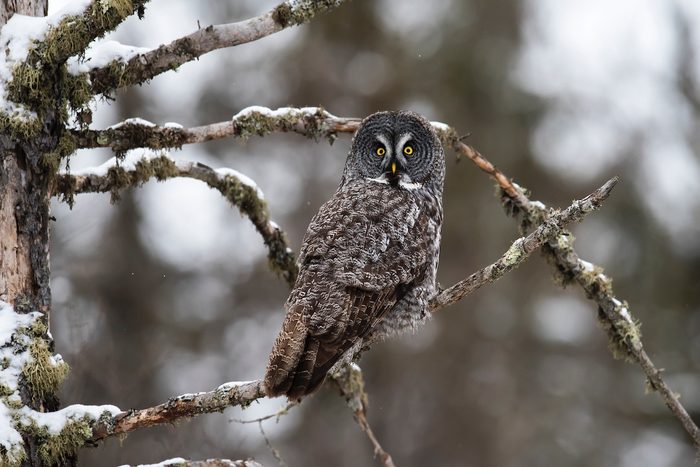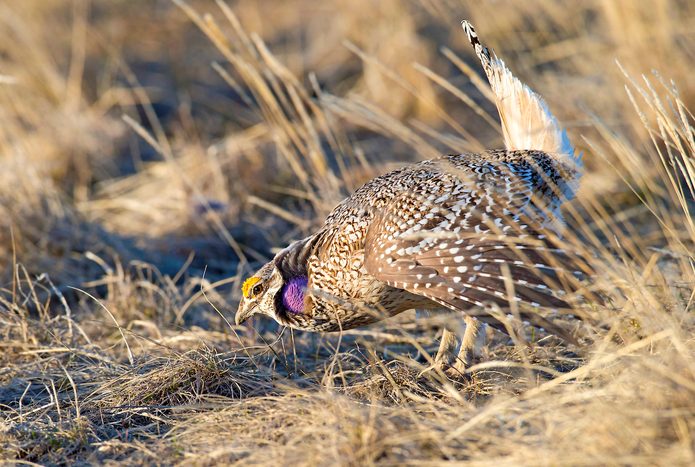Go birding across America—just grab a pair of binoculars and hit the road. Check out our favorite birding hotspot in each state!
The Best Birding Hotspot in Every State

Alabama: Dauphin Island
As cold fronts move southward, bringing rain and wind, many migrating birds make this island their first spring landfall as they make their way across the Gulf from Mexico or Central America. But even if you don’t come to watch neotropical birds fall from the sky (a breathtaking sight), there are still 164 acres of maritime pine forests, marshes and dunes to explore with winding birding trails throughout. Over 400 bird species have been observed on Dauphin Island, including Swainson’s warblers and black-whiskered vireos.
Runner-Up: Bon Secour National Wildlife Refuge

Alaska: Kenai Fjords National Park
Drive three hours south from Anchorage and you’ll reach the Kenai Fjords National Park, where you can take specialized birding tours along the craggy coastline by boat, car or on foot. Nearly 200 species of birds have been documented in the park, like peregrine falcons, puffins (horned and tufted), black oystercatchers and marbled murrelets just to name a few.
The park itself is set in the Kenai Peninsula and if you’re in the area in May, don’t miss the Kenai Birding Festival. Both novices and advanced birders will enjoy learning from bird experts, socializing with fellow bird nerds and taking raft trips down the Kenai River to see how many species they can spot.
Runner-Up: Copper River Delta
![Standing Rocks [rhyolite Formation] At Sunset. Heart Of Rocks Area. Chiricahua National Monument, Arizona.](https://www.birdsandblooms.com/wp-content/uploads/2024/07/CE9B9B-e1720034259786.jpg?fit=700%2C561)
Arizona: Chiricahua Mountains
See something unexpected when you visit the Chiricahua Mountains, like 13 species of hummingbirds, some of which are Mexican species rarely seen elsewhere north of the border. And don’t forget to make a stop at the Chiricahua National Monument, towering rock formations of rhyolite formed after a volcanic eruption millions of years ago. Many birds call this area home, including golden eagles and zone-tailed hawks. In the forested canyon bottoms, look for Arizona woodpecker and Grace’s warbler.
Runner-Ups: Ramsey Canyon Preserve and Sweetwater Wetlands

Arkansas: Ouachita National Forest
Cruise along Lake Ouachita on an organized bald eagle tour to observe the birds wintering in the area. Make sure to keep your eyes on the water, too, because many loons spend winters on the lake. Come back in July and August to see tens of thousands of purple martins roosting on Bird Island. There’s plenty to see away from the lake, too, like brown-headed nuthatch and red-cockaded woodpecker.
Runner-Up: Cache River National Wildlife Refuge

California: Sonny Bono Salton Sea National Wildlife Refuge
Just north of El Centro, California, this wildlife refuge provides a habitat for wintering water birds like snow and Ross’s geese, northern pintails, eared grebes and brown pelicans. It’s the best place in the U.S. to find the yellow-footed gull, most numerous in late summer and fall.
November through May are the best months for birdwatching at the Salton Sea, with heavy migrations of waterfowl, marsh and shorebirds during spring and fall. With more than 375 species of birds recorded, the Salton Sea has one of the most diverse ranges of species in the West.
Runner-Up: San Elijo Lagoon

Colorado: Pawnee National Grasslands
Transform your car into a bird blind when you take a self-guided driving tour through this short grass prairie that covers more than 193,000 acres. You’ll be surprised by how many bird species you can spot up-close from your car—the trick is to drive slowly, so you don’t miss any of the 301 species that have been observed here! (Visitors on foot are more likely to scare away prairie residents.)
A few birds you can expect to see include the lark bunting, burrowing owl, mountain plover and horned lark. Late spring is a great time to see the grasslands in full bloom. Make sure to check out Chalk Bluffs, a nesting site for ferruginous hawks, prairie falcons and Swainson’s hawks.
Runner-Up: Arapaho National Wildlife Refuge

Connecticut: Coastal Center at Milford Point
Situated on an 8.4-acre barrier beach, there are plenty of birdwatching opportunities to take advantage of at the Coastal Center, like the 70-foot observation tower for a panoramic, bird’s-eye view. Over 300 species of birds have been observed at Milford Point, with the area’s 840-acre saltwater marsh being an important stop for many migrating birds.
Besides providing a variety of habitats, like coastal dunes and tide pools, the Coastal Center also educates the public on the importance of preserving the ecosystem. You can even experience a piece of the Coastal Center without leaving home by going online at ctaudubon.org to watch their seasonal live stream of an osprey nest.
Runner-Up: White Memorial Conservation Center

Delaware: Bombay Hook National Wildlife Refuge
Pace yourself; there’s a lot to see at Delaware’s most popular birding site, like hundreds of thousands of greater snow geese in the winter and songbirds in the spring. Open every day of the year from sunrise to sunset, the refuge spans nearly 16,000 acres and features five walking trails and three observation towers.
There’s also a road that loops around the refuge’s salt marshes, mudflats, woodlands and fields, so you can experience the wildlife from your vehicle as well. Don’t forget to stop by the Visitor Center to read the bird-sighting log and add a few of your own observations.
Runner-Up: White Clay Creek State Park

Florida: J.N. “Ding” Darling National Wildlife Refuge
This refuge gets its funny-sounding name from the pioneer conservationist it was named after. Home to over 245 bird species, including roseate spoonbill, red-shouldered hawk and white ibis, this refuge was created to protect endangered species and supply roosting areas for migrating birds. There are plenty of trails to walk, and visitors can also explore the refuge by bicycle. Volunteers track weekly bird observations online at fws.gov/dingdarling, and visiting birders can join in on the fun, too.
Runner-Up: Corkscrew Swamp

Georgia: Jekyll Island
Ten miles of tidal beaches means plenty of shorebirds, wading birds and waterfowl to add to your birding life list, like American oystercatchers, marbled godwits, northern gannets, piping plovers and black skimmers. You’ll find scoters and loons swimming offshore, and clapper rails and marsh wrens lurking in the salt marshes.
When you’re ready for a change of pace, take a guided turtle walk around the island and see if you can spot nesting loggerhead sea turtles.
Runner-Up: Okefenokee National Wildlife Refuge

Hawaii: Waikamoi Preserve
There are only an estimated 500 kiwikiu or Maui parrotbills left in the world, and the best place to see them is at the Waikamoi Preserve, a 8,951-acre sanctuary for threatened and endangered Hawaiian birds located on East Maui. Other native birds you might see include the crimson ‘apapane and the yellow-green ‘amakihi.
Because of how delicate this habitat is, a guided hike led by an ornithologist from the National Park Service is the best way to experience everything the preserve has to offer, so plan ahead. It will be worth the effort for this once-in-a-lifetime experience.
Runner-Up: Hawaii Volcanoes National Park

Idaho: Morley Nelson Snake River Birds of Prey National Conservation Area
If you’re a raptor fanatic, this conservation area, which boasts the highest density of nesting raptors in North America, is a must-visit. Watch for bald eagles, ferruginous hawks, red-tailed hawks, golden eagles and American kestrels. Along the Snake River Canyon, 150 to 200 pairs of prairie falcons nest every year. But there aren’t just raptors here—songbirds like lazuli bunting and Say’s phoebe also nest in the riparian bottomlands.
Runner-Up: American Falls Reservoir

Illinois: Montrose Point Bird Sanctuary
Although this sanctuary is small, it still has a lot to offer, particularly during spring and fall migration when sparrows like white-crowned, Lincoln’s and fox fill the meadow in the center of the sanctuary. Over 300 species of birds have been observed here, including extreme rarities such as reddish egret, Barrow’s goldeneye and mottled duck. Come back during the winter months to see snowy owl, short-eared owl, snow bunting and Lapland longspur.
Runner-Up: Carlyle Lake

Iowa: Cone Marsh Wildlife Area
You’ll have to leave your tent and camping gear at home when you visit this marshy area, because it’s purposefully kept in an undisturbed state. That’s good news for bird-enthusiasts, though, because the lack of human commotion makes for some choice bird-watching opportunities. Birds that have been spotted in this lowland area include rusty blackbirds, lark sparrows, black-crowned night-herons and swamp sparrows.
Runner-Up: Makoke Trail

Indiana: Indiana Dunes National Park
Any one of this state park’s trails through prairie, savanna, beach and dune habitats will net plenty of bird sightings, but the two best trails for birders are Trails 2 and 10. Take Trail 2 and enjoy a mile-long boardwalk where you can spot nesting woodland birds like hooded warbler, veery and red-shouldered hawk. Trail 10 runs along the high dunes and is a great spot to see pileated woodpeckers.
Other birds that have been observed in the 2,182-acre park include little blue heron, harlequin duck and Kirtland’s warbler. (Psst—check out the “3 Dune Challenge,” if you’re up for a serious hike.)
Runner-Up: Goose Pond Fish and Wildlife Area

Kansas: Cheyenne Bottoms
Smack-dab in the middle of the United States, Cheyenne Bottoms is a primary migration route for hundreds of bird species. This 41,000-acre wetland has a quarter million waterfowl and shorebirds thaaut use it as a migration pit stop every year. Spring is the best time to visit, with wading birds like herons and sandhill cranes arriving in March and April, and shorebirds like dowitchers and lesser yellowlegs arriving in early May.
Runner-Up: Cimarron National Grassland

Kentucky: John James Audubon State Park
It would be hard to find a birder who hasn’t heard the name “Audubon.” John James Audubon was a pioneer naturalist who wrote and illustrated The Birds of America over several decades in the early 1800s. From 1810 to about 1819, he lived in Henderson, Kentucky, where this park and museum now display many of his original prints.
Once you’ve experienced some birding history firsthand, take off on one of the nine hiking trails on the property, and see the birds and wildlife that helped to inspire one of America’s finest ornithologists.
Runner-Up: Mammoth Cave National Park

Louisiana: Grand Isle
Although this barrier island is one of the top Louisiana birding hotspots at any time of year, the best month to visit Grand Isle is in April during the Migratory Bird Celebration. This event includes activities like bird-watching tours, bird presentations, and even some bird-related games and prizes for kids. Walk through Grand Isle’s oak-hackberry woods during spring migration and see how many species, like orioles, grosbeaks and buntings, you can spot.
Runner-Up: Peveto Woods Bird & Butterfly Sanctuary

Maine: Machias Seal Island
Climb aboard a tour boat and take a trip across the Bay of Fundy to this 15-acre island and breeding colony. You’ll see Atlantic puffin, razorbill, common murres and common and arctic terns up close and personal.
Schedule your trip in summer to see those species, and make sure you call far in advance. Island landings are limited due to the island being a designated sanctuary. (But don’t worry—you can see just as much from the boat!)
Runner-Up: Acadia National Park

Maryland: Conowingo Dam
Whether you come for the bald eagles and stay for the gulls, or the other way around, there’s a lot to see at Conowingo Dam. When December rolls around, the bald eagle population grows, and if you patiently wait, you’ll get to see them diving for fish. This is also a great time to watch for gulls, which can number in the thousands and often include a few rare species. Plus, don’t miss the great blue herons that reside here all year long.
Runner-Up: Assateague Island National Seashore

Massachusetts: Plum Island
Although this popular birding spot is an island, visitors can still get there by car thanks to a short bridge connecting it to the mainland. A classic spot to see snowy owls, the spring and fall seasons also attract a variety of waterfowl and songbirds. By late summer, the shorebird migration is in full swing.
Runner-Up: Sudbury Reservoir

Michigan: Whitefish Point Bird Observatory
Located on Lake Superior, tens of thousands of migrating birds, like whimbrels, blue jays, and sharp-shinned hawks, pass through this peninsula to reach their northern breeding grounds in spring or warmer winter homes in fall. And if you love owls, make sure to visit in April through mid-May, when species like boreal, great gray, great horned, short-eared and long-eared owls are passing through.
Runner-Up: Kellogg Bird Sanctuary

Minnesota: Sax-Zim Bog
From December to March, Sax-Zim Bog in northern Minnesota becomes home to uncommon boreal birds from Canada. Grab all of your warm clothing and head outdoors to find winter specialties, like boreal chickadee, pine grosbeak, evening grosbeak and maybe even a great gray owl.
Runner up: Voyageurs National Park

Mississippi: Noxubee National Wildlife Refuge
Short on time, but still want to cross a bird off your life list? Walk along the half-mile woodpecker trail at this 48,000- acre refuge, where you’ll not only be able to spot many woodpecker species native to the area, but the endangered red-cockaded woodpecker, as well.
Of course, it’s easy enough to spend the entire day at the refuge, exploring the many hiking trails and observing more birds like barred owl, northern bobwhite and wood ducks. (But watch out for gators!)
Runner-Up: Gulf Islands

Missouri: Ted Shanks Conservation Area
Grab your favorite spotting scope and explore the diverse surroundings of this 6,705-acre area. Bottomland forests create excellent nesting habitats, and waterfowl are drawn to the many lakes and pools. A few of the species that have been observed here include yellow-billed cuckoo, Mississippi kite, American tree sparrow and great blue heron. You can also go back in the evening for some great night birding opportunities.
Runner-Up: Swan Lake National Wildlife Refuge

Nebraska: Rowe Sanctuary
Thousands of sandhill cranes fill the skies of Nebraska every year, and one of the best spots to observe this heart-stirring spectacle is the Rowe Sanctuary. In March and early April, trained guides lead visitors out to strategically placed blinds to watch the cranes land along the Platte River. The sanctuary also hosts educational workshops, so visitors can learn even more about these fascinating birds.
Runner-Up: Fort Niobrara National Wildlife Refuge

Montana: Glacier National Park
This one is a classic birding spot that’s impossible to beat. The gorgeous mountain scenery is an excellent backdrop for the more than 260 species of birds that can be found here, like white-tailed ptarmigan, dusky grouse and chestnut-backed chickadee. A particularly good birding trail is the McDonald Creek Oxbow, where you’ll find a diverse array of warblers, plus harlequin ducks.
Runner-Up: Medicine Lake National Wildlife Refuge

Nevada: Ash Meadows National Wildlife Refuge
Don’t be fooled by this refuge’s desert location. Thanks to its many oases, including the largest oasis in the Mojave Desert, this 28,000-acre refuge has wetlands and springs, making for some amazing biodiversity. One can’t miss bird-watching spot at the refuge is the Crystal Reservoir, where a clear shoreline will leave you with views of western grebe and cinnamon teal. Plus, look for Virginia rails and soras at Point of Rocks.
Runner-Up: Ruby Lake National Wildlife Refuge

New Hampshire: White Mountain National Forest
Songbirds like the American redstart and black-throated blue warbler spend their summers in this forest to build their nests and raise their babies, so the best time to visit is in late spring and early summer. There are plenty of year-round residents to observe as well, like great horned owls, nuthatches and downy woodpeckers.
When you want a bird-watching break, go on a scenic drive on the Kancamagus Highway and take in the highest mountains in this part of the U.S.
Runner-Up: Odiorne Point State Park

New Jersey: Cape May Bird Observatory
Swap your best bird stories with other birders at the Hawk Watch Platform in fall, while you observe the passage of migrating hawks, like sharp-shinned hawk, broad-winged hawk and peregrine falcon.
The observatory also organizes the World Series of Birding, a 24-hour competition where the winning team has to spot the most bird species.
Runner-Up: Sandy Hook

New Mexico: Bosque del Apache
This refuge is popular with wildlife photographers for a reason. No matter what season you visit this refuge along the Rio Grande, you won’t be disappointed. Winter here means sandhill cranes, snow geese and Ross’s goose. Summer will give you the opportunity to see least bittern and occasionally white-faced ibis.
Spring and fall are also excellent times to visit thanks to hundreds of migrating bird species. It’s impossible to see everything this refuge has to offer over the course of just one season, so return visits are a must.
Runner-Up: Sandia Crest

New York: Jamaica Bay Wildlife Refuge
When you think of New York City, you probably don’t picture acres of wetlands, but this refuge, nestled between Brooklyn and Queens, will surprise you. Over the last 25 years, more than 325 bird species have been observed here, like Eurasian wigeon, green-winged teal and northern pintail.
One of the best birding spots here is the East Pond, 100 acres of marsh that thousands of shorebirds use as a stopover during late summer and fall migrations.
Runner-Up: Adirondack Mountains

North Carolina: Pea Island National Wildlife Refuge
There’s a good reason this 31,543-acre refuge was primarily established as a habitat for migrating birds. It’s because hundreds of bird species stop here during migration. Ospreys and bald eagles take advantage of the opportunities to nest near open water, while least tern and American oystercatchers reside along the refuge’s ample beaches.
There are plenty of trails to walk, but you can also get off the beaten path via kayak.
Runner-Up: Chimney Rock State Park

North Dakota: Lostwood National Wildlife Refuge
Glaciers from 10,000 years ago are responsible for this area’s rolling hills and wetlands. One of the largest mixed grass prairies in the United States, this refuge is home to over 243 bird species, like sharp-tailed grouse, Sprague’s pipit and grasshopper sparrow. Once thought to be extinct, giant Canada geese have also been reintroduced to the area and now commonly nest here.
Runner-Up: J. Clark Salyer National Wildlife Refuge

Ohio: Magee Marsh Wildlife Area
This is one of those birding spots you’re going to come back to year after year—and you won’t be alone. Thousands of bird enthusiasts flock to this area for the Biggest Week in American Birding festival, a 10-day festival that celebrates everything birding while boasting dozens of warblers.
But even if you don’t come for the festivities, there’s plenty to enjoy, and the famous boardwalk is worth walking any time of the year.
Runner-Up: Killdeer Plains Wildlife Area

Oklahoma: Black Mesa State Park
About 30 million years ago, a layer of black lava rock coated this mesa, which is where it gets its name. Today, there’s no lack of bird species, like scaled quail, black-chinned hummingbirds, black-billed magpies, pinyon jays and many more.
Once you’ve added a few birds to your life list, wait until after dark for a special treat: every August, the Perseid meteor shower is extremely visible in the night sky.
Runner-Up: Little River National Wildlife Area

Oregon: Upper Klamath National Wildlife Refuge
This freshwater marsh is paradise for thousands of water birds, like American white pelican, black-crowned night heron and black tern. Grab a paddle and make your way down the 9.5-mile canoe trail that winds its way through the marsh. This is a great way to see even more bird species, like Virginia rail, Clark’s grebes and sora.
Runner-Up: Coos Bay

Pennsylvania: Middle Creek Wildlife Management Area
Want to witness something truly spectacular? Visit Middle Creek in March to watch as hundreds of thousands of migrating snow geese, tundra swans and Canada geese come to roost on the 360-acre lake at dawn and dusk. When summer rolls around, look for bobolinks and other songbirds.
There are plenty of trails to explore, but if you’re looking for a touch more adventure, try a few of the available equestrian trails.
Runner-Up: Hawk Mountain Sanctuary

Rhode Island: Trustom Pond National Wildlife Refuge
It will be hard to walk away from this refuge without becoming more of a bird expert, thanks to the knowledgeable volunteer staff at the visitor station, plus the detailed interpretive panels scattered throughout the 2 miles of nature trails and four viewing platforms.
As the only undeveloped coastal salt pond in Rhode Island, this refuge is an important habitat for 300 bird species, like least tern and piping plover, which use the barrier beach as a nesting site.
Runner-Up: Sachuest Point National Wildlife Refuge

South Carolina: Huntington Beach State Park
If you’re going to hit one birding spot in South Carolina, make it this one. Winter is the best time to explore this park, because it’s when you’re most likely to see resident bald eagles and various waterfowl, like gadwall and green-winged teal. Walk over to the jetty to observe black skimmers and royal tern. If you look really close, you might be able to see camouflaged purple sandpipers as well.
Runner-Up: Savannah National Wildlife Refuge

South Dakota: Black Hills
There’s so much to see in the Black Hills of western South Dakota, but a few highlights include the ponderosa pine forests, where pine siskin, red crossbill and red-breasted nuthatch reside. Walk further up the mountain where white spruce forests become more common, and you’ll find three-toed woodpeckers, brown creepers and golden-crowned kinglets.
And of course, you’d be amiss if you didn’t stop to see Mount Rushmore while you’re there!
Runner-Up: Sand Lake National

Tennessee: Great Smoky Mountains National Park
A day of birding in this popular national park is going to be a very rewarding one: If you know most birds by sight and sound, you’ll easily see 100 species a day during peak migration in late April and early May. There’s a dizzying amount of habitat diversity here.
Southern hardwoods at low elevations have yellow-billed cuckoos, Louisiana waterthrushes and black-and-white warblers, while open fields have red-tailed hawks, killdeer and yellow warblers. And that’s just a start!
Runner-Up: Reelfoot National Wildlife Refuge

Texas: Rio Grande Valley
Everything is bigger in Texas, and that includes birding sites. The Rio Grande Valley is home to nine unique bird-centric locations, like the Bentsen-Rio Grande Valley State Park where you’ll be able to spot plenty of kiskadees, green kingfishers and plain chachalacas, and the Roma Bluffs, which are home to red-billed pigeon and brown jay.
Don’t miss the Rio Grande Valley Birding Festival in November.
Runner-Up: Guadalupe Mountains National Park

Utah: Antelope Island State Park
Although this park is most known for its bison herd, there’s plenty here for bird nerds, like huge populations of black-necked stilts, white-faced ibis and California gulls that nest along the Great Salt Lake. The island itself has a lot of grassland habitat for burrowing owls, chukars and long-billed curlews.
Runner-Up: Ouray National Wildlife Refuge

Vermont: Dead Creek Wildlife Area
Despite the name, this wildlife area is incredibly lively, with over 200 species of birds and 3,000 acres of deciduous forests, fields and wetlands. It also boasts a surprising number of state endangered species, like grasshopper sparrows and upland sandpipers.
But even if you don’t catch a glimpse of these threatened birds, there’s still plenty to see, including enormous flocks of Canada geese and snow geese. They use this area as a stopover during migration season.
Runner-Up: Missisquoi National Wildlife Refuge

Virginia: Kiptopeke State Park
If you’ve ever wanted to see bird banding up close, this is the place. Songbirds have been banded at this station since the early 1960s, and a raptor banding station has since been added. From September through November, volunteers record the number of hawks that fly overhead. (Since the program started, they’ve counted nearly 750,000 hawks!)
Runner-Up: Chincoteague National Wildlife Refuge

Washington: Olympic National Park
As far as gorgeous backdrops go, it’s hard to beat the lush rainforests and breathtaking mountaintops of Olympic National Park. It’s also hard to beat the diverse number of bird species the park has to offer at more than 250. Woodpeckers, blue grouse and Canada jays can be found in the mountain meadows, while rhinoceros auklets and western gulls nest along the coast.
To cover more ground, take the Olympic Loop, a self-guided driving tour of the park.
Runner-Up: Grays Harbor

West Virginia: Green Bottom Wildlife Management Area
No matter what time of year you visit this 1,096-acre wildlife habitat, there’s no shortage of bird species to see. Located on a former plantation and along the banks of the Ohio River, over 100 species of birds are seen here regularly, like wood ducks, bald eagles and great blue herons.
Nesting boxes and 14 manmade nesting islands help encourage more birds to make themselves at home.
Runner-Up: Cranesville Swamp Natural Area

Wisconsin: Horicon Marsh
There’s always something going on at the Horicon Marsh, the largest cattail marsh in the United States at over 33,000 acres. More than 304 birds have been spotted in this internationally recognized wetland, though what this ecosystem is best known for is being a stopover for Canada geese.
If you’d really like to dive in, visit this one of our favorite birding hotspots during the annual Horicon Marsh Bird Festival and take part in boat tours, demonstrations of bird banding, night sound hikes and more.
Runner-Up: Crex Meadows State Wildlife Area

Wyoming: Grand Teton National Park
Just south of Yellowstone, the 300 bird species that have been sighted here are as extreme as the landscape. You can spot both the smallest bird in North America, the calliope hummingbird, and the largest waterfowl, the trumpeter swan, in this park.
With more than 200 miles of trails to explore, you’ll never run out of options. Other notable species that have been spotted here include three-toed woodpecker, great gray owl, osprey and Brewer’s sparrow.
Runner-Up: Edness K. Wilkins State Park

Birding Hotspots in Canada
Look to our northern neighbor for even more excellent birding spots like these.
- Point Pelee National Park, Ontario Migratory stop for nearly 200 species, like piping plover.
- Kejimkujik National Park, Nova Scotia Visit in the spring for northern parula and common loon.
- Cape Breton Highlands National Park, Nova Scotia A great spot for northern species like spruce grouse, boreal chickadee and pine grosbeak.
- Beaverhill Lake, Alberta Home to the Beaverhill Lake Bird Observatory, which has been banding birds and promoting conservation since the ’80s.





















